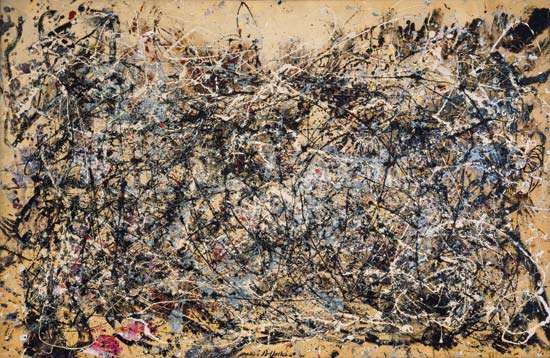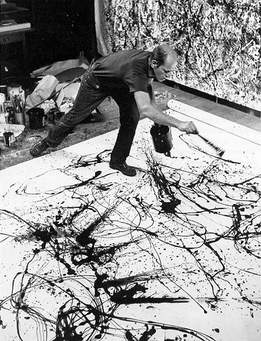Discovering the artist Jackson Pollock
Jackson Pollock
Your Assignment is to do the reading, watch the video, create a computer painting, and complete the assessment below.
Paul Jackson Pollock, (1912 – 1956) was an American painter and a major figure in the abstract expressionist movement. This movement was established by artists who sought to express themselves from the subconscious. They believed that the source of all creativity was born from an inner self that does not rely on the mind but the spirit or soul.
He was widely noticed for his technique of pouring or splashing liquid household paint on to a horizontal surface (‘drip technique’), enabling him to view and paint his canvases from all angles. It was also called ‘action painting’, since he used the force of his whole body to paint, often in a frenetic dancing style. This extreme form of abstraction divided the critics: some praised the immediacy and fluency of the creation, while others derided the random effects. In 2016, Pollock's painting titled Number 17A was reported to have fetched US$200 million in a private purchase.
Number 17A
A reclusive and volatile personality, Pollock struggled with alcoholism for most of his life. In 1945, he married the artist Lee Krasner, who became an important influence on his career and on his legacy. Pollock died at the age of 44 in an alcohol-related single-car accident when he was driving. In December 1956, four months after his death, Pollock was given a memorial retrospective exhibition at the Museum of Modern Art (MoMA) in New York City. A larger, more comprehensive exhibition of his work was held there in 1967. In 1998 and 1999, his work was honored with large-scale retrospective exhibitions at MoMA and at The Tate in London.
As a man, Pollock was described by his contemporaries as gentle and contemplative when sober, violent when drunk. These extremes found equilibrium in his art. He was highly intelligent, widely read, and, when he chose, incisively articulate. He believed that art derived from the unconscious, saw himself as the essential subject of his painting, and judged his work and that of others on its inherent authenticity of personal expression.
Number 1A
In 1947 Pollock first used the process of pouring or dripping paint onto a flat canvas in stages, often alternating weeks of painting with weeks of contemplating before he finished a canvas. This process allowed him to record the force and scope of his physical gesture in trajectories of enamel or aluminum paint. At the time, he said these abstract trajectories “veiled the image,” or the traces of figuration, that had often been apparent in his earlier work. Recent research has indicated that his “veiling” constituted a form of free association from which he began most of his major paintings. The results, in effect, were huge areas covered with complex linear patterns that fused image and form; these works engulfed the spectator in their scale and intricacy. A whole series of paintings—beginning with Full Fathom Five (1947) and Lucifer (1947) and proceeding through Summertime (1948), Number Ten, 1949 (1949), the mural-sized canvases of 1950 such as One, Autumn Rhythm, and Lavender Mist, and the black and white Number Thirty-two, 1950 (1950)—display the infinite variety of effect and expression he achieved through the method of “poured” painting.
Title: Autumn Rhythm
Title: Number 10
Create a Jackson Pollock on the computer! Go to the web site (cut and paste it in the url address bar)
Jacksonpollock.org
then go to the bottom of the page and click on the white area while moving your mouse around. You will be able to make Pollock like gestures by throwing your paint. When you release your hand a new color appears when you start again on the white canvas! See an example below.
Pollock formed a dance around his canvas of moving with a form rhythm. He would move the paint with his wrist to create different patterns of paint on the surface.
Jackson Pollock posing in his studio.
Pollock painted on the floor using sticks and house paint.
Create your own drip painting on the computer!










